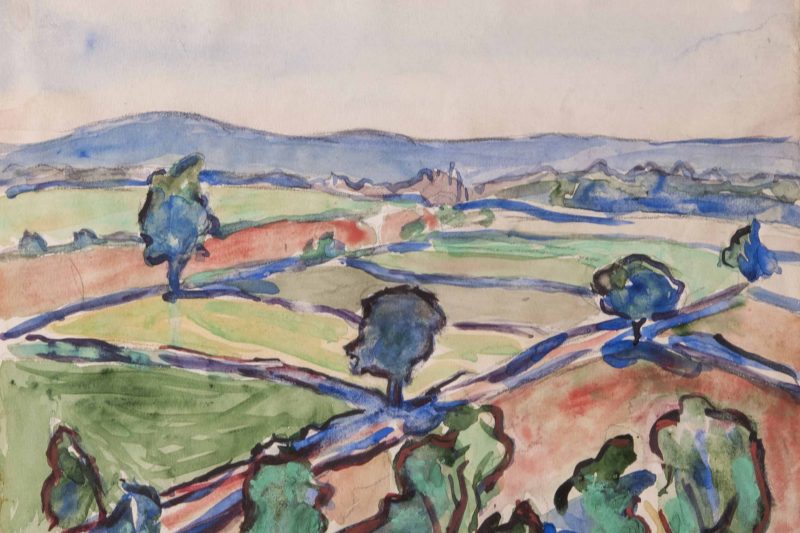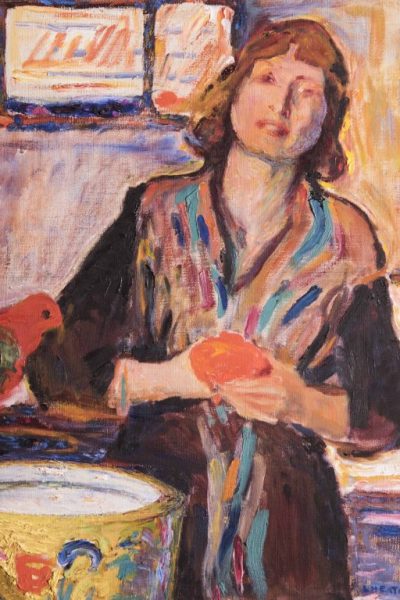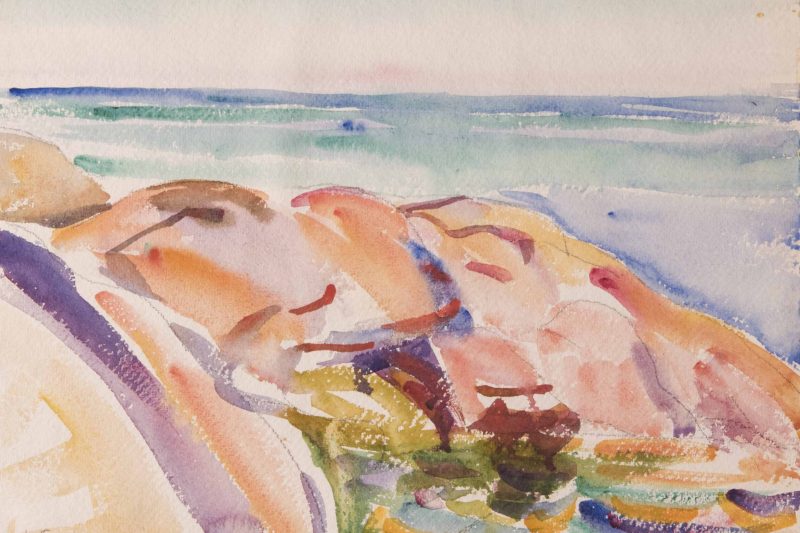Thinking Outside the (Gallery) Box “To See Color First,” the first comprehensive study of Louise Herreshoff Eaton’s bold and expressive watercolors, opens April 27 as a virtual exhibition.
On April 27, the Staniar Gallery at Washington and Lee was scheduled to end its 2019−2020 season with an exhibition entitled “To See Color First,” the first comprehensive study of Louise Herreshoff Eaton’s bold and expressive watercolors, which figure prominently in W&L’s permanent museum collection. Organized by Staniar Gallery Director Clover Archer and co-curated by Patricia Hobbs, senior curator of art for the Museums at W&L, and Tracy Bernabo, curator of Try-me Gallery in Richmond, Virginia, the exhibition was to be the first significant public display of Herreshoff’s work outside of the University’s Reeves Museum since 1976.
Plans were made, an exhibition catalog detailing new information about Herreshoff’s work was designed and printed, and the artwork was delivered for framing. Then, the closures and social distancing brought on by the COVID-19 pandemic were imposed, and life for us all changed radically. Students went home, university staff began to work remotely where possible, and plans for the Staniar Gallery exhibition were put on hold.
However, working through our own professional and personal disappointment, Clover Archer and I decided to “mount” the exhibition and “open” it regardless of the restrictions. Our platform will be digital rather than physical, with the paintings grouped as they might be on the walls in the Staniar Gallery. There will be no opening reception, but the online exhibition and a digital version of the exhibition catalog has been launched.
Louise Chamberlain Herreshoff Eaton Reeves (1876−1967), along with her second husband, Euchlin D. Reeves ’27L (1903−1967), is familiar to the W&L community as the donor of a notable collection that forms the basis of what is now the Reeves Museum of Ceramics. Thanks to that gift, Herreshoff is also known for her brightly colored paintings that accompanied the ceramics.
In his book, “A Fragile Union,” founding Reeves Center director James W. Whitehead traced Herreshoff’s biography from birth to death, but he did not delve into the cultural context of her art. In the catalog that accompanies the new exhibition, the co-curators track Herreshoff’s artistic development and demonstrate the significance of her oeuvre as a reflection of the dynamic times in which she worked. Her paintings reveal her understanding and exploration of contemporary art movements, including impressionism, post-impressionism and fauvism.
The exhibition focuses on Herreshoff’s later work created in Providence, Rhode Island, and on Cape Ann, Massachusetts, where she shared exhibition space with well-known artists such as Frederick Childe Hassam and Maurice Prendergast. In Gloucester, she may have painted in the company of notable artists Cecilia Beaux, John Sloan, Stuart Davis, Milton Avery and Jane Peterson. It builds on new research conducted not only by the curators, but also by four 2019 summer museum interns: Charlotte Cook ’19, Matthew Richards ’19, Laurel Myers ’20 and Virginia Laurie ’22. As one of their projects, they each transcribed a group of Herreshoff’s letters that were donated earlier in the year to the Special Collections Library & Archives.
A crucial aspect of an academic gallery like the Staniar involves mounting temporary exhibitions of works that enhance the courses and curriculum in the Department of Art and Art History. Archer writes in her catalog foreword for “To See Color First,” “Typically on view for 4-5 weeks, the shows are designed to expose students to a broad array of art and topical creative explorations. These exhibitions model a diverse range of creative practice and related discourse, but in-depth study of the original artworks is not possible given the brief amount of time the works are on campus. Thus, the chance to mount an exhibition from the university’s permanent collection provides an exciting opportunity to expand the pedagogical role of the gallery.” She continues by noting that “the curators’ new research shines light on the life and works of this relatively unknown painter, sparking new lines of inquiry that imbue the university’s rich collection of Herreshoff’s paintings with fresh relevance for students and future scholars.” The focus of all exhibitions that we create, both for the Staniar and the Museums, is our students and expanding their learning opportunities both in and out of the classroom.
“To See Color First” was not the only exhibition in the Staniar Gallery line-up that was canceled for the season. Because of the COVID-19 public health crisis, Washington and Lee’s Studio Art majors, Angela Delos Reyes, Ashley Gillen and Allison Young, will now present their senior thesis projects virtually in an exhibition created by 2020 Staniar Gallery interns Lindsey Hewitt ’21, Victoria Morgan ’20, Darcy Olmstead ’21 and Kassidy Strosnider ’20.
The Museums at W&L also have been working hard to create additional online exhibitions that highlight the collections and support remote learning. Two of those reprise past exhibitions that incorporated student participation. “Modern Art Goes Pop!” originally opened in Staniar Gallery in late 2016 and drew from the university’s art collection to explore the points at which two major 20th century art movements, pop art and hard-edge abstraction, intersected and diverged. Students in ARTH 364: Art of the Sixties, taught by Elliott King, associate professor of art history, wrote extended labels for each featured work at the time. These are included in the virtual exhibition, which is now accessible to current remote learning art classes, as well as the public at large.
Additionally, “Dance Photographs of Jack Mitchell” was curated by 2018 summer museum intern Liza Aldridge ’21 from the W&L art collection for exhibition in Wilson Hall that Fall Term. Today, Professor Jenefer Davies is using the exhibit’s digital images as part of her remote dance classes.
Also available as an online exhibition is “Breaking the Chains: Ceramics and the Abolition Movement,” which is still on display in the Watson Galleries through summer 2020. The virtual exhibition was developed as a concurrent supplemental resource, as well as a long-term record of the exhibit. The online exhibition has the ability not only to enhance the museum collection’s accessibility for our students, but also to reach audiences outside of the university community. We recently learned that an 8th grade teacher is using it in her remote learning world history class and is also sharing it more broadly.
At its core, the Museums at W&L advances learning through direct engagement with collections, as does the Staniar Gallery. Classes reflecting multiple disciplines − art history, history, economics, German, chemistry, accounting, dance, theater and religion − have all used the museums’ permanent collections. Online resources are meant to be supplemental, as well as to expand accessibility. They are not, however, a substitute for the real thing. Any student who has taken an art history class followed by a museum trip can attest that seeing works in real life reveals both physical and intangible aspects of art and artifacts that an encounter with a digital image can only begin to offer.
While the future is uncertain, we still plan to mount the watercolors of Louise Herreshoff Eaton as a physical exhibition. When it is possible, the works will be installed either in the Staniar Gallery or in the Watson Galleries. I also plan to curate an exhibition of Herreshoff’s oil paintings of Cape Ann for the Gottwald Gallery in the Reeves Museum. We will let the community know what plans unfold. In the meantime, we hope you will enjoy the virtual exhibition of the watercolors of “To See Color First.”
Click here to see the online exhibition and a digital version of the exhibition catalog.
 “Across the Fields,” watercolor on paper by Louise Herreshoff
“Across the Fields,” watercolor on paper by Louise Herreshoff “Parrot (Self Portrait),” oil on canvas by Louise Herreshoff
“Parrot (Self Portrait),” oil on canvas by Louise Herreshoff “Rocks No. 2,” watercolor on paper by Louise Herreshoff
“Rocks No. 2,” watercolor on paper by Louise Herreshoff
You must be logged in to post a comment.